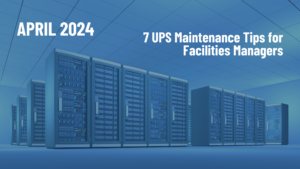Written by Nate Joseph s
s
Facilities managers appreciate the importance of maintaining mission-critical assets supporting the organization. The Uptime Institute’s book “Accredited Operations Specialist” reinforces this by stating maintenance is the “second most important category to meeting uptime objectives” only second to “staffing and organization”. A good maintenance program reduces risk by uncovering potential issues before they become worse or cause outages. Quality maintenance also saves money by avoiding costly emergency repairs and maximizing an asset’s lifespan. The uninterruptable power source (UPS) provides seamless power transition from utility power to generator, conditioning power, and may be the sole power source during an outage. Therefore, UPS maintenance deserves special attention.
The following seven tips can help facilities managers maintain their UPS systems:
1. Take inventory: Recording the location, make, model, and serial number of all UPS systems may seem straightforward, but surprisingly many UPS systems inconspicuously hide in remote corners for years quietly protecting vital equipment from power issues. Taking inventory reveals all “flavors” of UPS systems hidden within an organization. This information helps facilities managers decide if updating, consolidating and/or standardizing a UPS is needed to ease maintenance headaches.
2. Determine the appropriate maintenance program: The maintenance scope will vary depending on the size and complexity of a UPS. A small “brick” UPS, such as an 850VA is typically simple to maintain and may only involve “hot swapping” batteries when they alert for replacement. In contrast, large UPS systems have multiple components including battery banks, capacitors, switchgear, fans, and air filters, all requiring maintenance. They may also have battery room ventilation systems and hydrogen monitors. Once the right UPS maintenance is determined for each UPS, it should be entered into a maintenance management system (MMS) with the correct maintenance frequency recorded for each maintenance task, either monthly, quarterly, semi-annually, or yearly.
3. Clarify “who does what”: Delineating which maintenance activities your in-house facilities staff can perform vs. using an outside vendor depends on whether your staff has the time and/or skills needed to complete maintenance beyond simple routine visual inspections. If they don’t, strongly consider setting up a UPS maintenance program through a qualified vendor.
4. Put a sticker on it: Once all UPS systems are located and you’ve documented who will perform the maintenance, put a sticker on each UPS showing the maintenance vendor’s emergency contact information. Having this vendor contact right on the UPS is invaluable during emergencies. Also, make sure the UPS make, model, and serial number are clearly shown as a vendor will ask for this information during troubleshooting.
5. Use a MOP: A detailed step by step process of how maintenance must be performed is important. A method of procedure (MOP) ensures the UPS maintenance is done the same way each time, without missing any pre-maintenance, maintenance, and post-maintenance steps. Pre-maintenance steps include workorder creation, approvals, vendor badge access, tools needed, PPE requirements, notification of change start, alert muting, etc. Maintenance steps include placing the UPS in bypass, shutdown, any lock out tag out (LOTO) of breakers, specific maintenance tasks, startup procedures, and returning to normal operations. Post-maintenance tasks include cleanup, sending completion notifications, ticket closure, and maintenance record updates.
6. Trust but verify: Ensuring your staff or UPS vendor provides timely and thorough UPS maintenance can be awkward, as double-checking someone’s work may be perceived negatively. However, performing random sampling of device log files can confirm if log data matches maintenance a technician allegedly performed. Also, requesting to have a different technician perform maintenance occasionally may reveal differences in quality of service.
7. Address other types of maintenance:
- Deferred maintenance: Delaying maintenance is never desired by facilities managers, but legitimate reasons such as bad weather can prevent scheduled maintenance. Proactive measures can be taken to minimize risk when deferring maintenance is unavoidable. One way is to reschedule maintenance as soon as possible to minimize the delay. A second way is to record deferred maintenance in your MMS and flag it separately from regular maintenance. This helps it clearly stand out in reports and not be overlooked.
- Predictive maintenance: Leveraging both historical and real-time data through monitoring and alerting enables facilities managers to evaluate the condition of equipment and predict when problems may arise before they occur. Predictive maintenance can also reveal if routine maintenance is too frequent and wasting money or uncover additional maintenance overlooked in the past.
A UPS plays an important role in providing uptime and power conditioning and they are sometimes the only power source available during a utility outage. Properly maintained, a UPS can reduce risk, save money, and deliver a longer lifespan. Following these seven UPS maintenance tips will help you identify UPS systems you own, choose the right maintenance program for each make and model, and determine who will provide the timely and high-quality maintenance your UPS systems deserve.